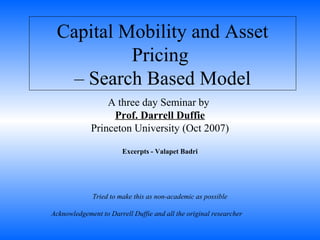search_eq_FI_appln
- 1. Capital Mobility and Asset Pricing â Search Based Model A three day Seminar by Prof. Darrell Duffie Princeton University (Oct 2007) Excerpts - Valapet Badri Tried to make this as non-academic as possible Acknowledgement to Darrell Duffie and all the original researcher
- 2. Are there Common explanations for ... FI MARKET - Cross-sectional Price Dispersion in âĒ Federal funds âĒ Muni Bonds âĒ Governtment Bonds Equity Market - Price behavior during âĒ Fire sale of equities by Mutual fund âĒ Listing/Delisting effect on individual stock prices from S&P 500
- 3. Search Theory âĒ Initial search theory was applied to labor market - conditions when an unemployed would accept an offer.(Stigler 1961, J Mcall 1970) âĒ Optimal search for a job depends on ïReservation wage (minimum acceptable wage) ïRisk tolerance and Free flow Job Information availability ïTime to wait to take an offer ïGreater variance of wages offered (similar to price dispersion)
- 4. Capital Markets âĒ So called âLaw of one priceâ â Think in terms of price dispersion â In Ideal Market (Job) the law of one price should be attainable âĒ It is typically, one for ask and bid price ----------------------------------------------- Applying these concepts to markets to explain capital movementï -----------------------------------------------
- 5. Market Conditions âĒ Capital and risk are not perfectly mobile âĒ Imperfect counter party searches ïHard to locate assets ïTrade through intermediation behavior ïthreaten execution delays, hence convey informational benefits and market power to dealers and other providers of immediacy. âĒ Time signature of price responses to supply shocks ïgives an indication of search friction ïCauses opaqueness and execution delays âĒ Supply shifts Vs.demand shifts after a loss
- 6. Search based pricing I. Capital Mobility ï Low premium markets to high premium markets ï Migration rate is considered Endogenous ï Limitations - âĒ intermediation costs âĒ search frictions ï Intensity of capital flows depends on the premium differential
- 7. II. Study of Post catastrophe market conditions ï Search Friction, intensity of capital flow determines behavior. ï Other factors âĒ Intermediation behavior - dealer efficiency and spreads âĒ Variation in liquidity among multiple assets
- 8. Search Models âĒ Several models proposed based on â Probability of Agent interaction in large/Small sample sets â Behavior of agents while bargaining given an outside option price â Information available on the market and each other motives â Dealer efficiency and spreads â âBoltzman cross- sectional â distribution
- 9. Evidence in Equity Markets âĒ Equity Market - Price Behavior of Individual Stocks - Large Markets âĒ Rebalancing of S&P 500 and price effect on the affected stock (no longer exists due to hedge, arb opportunity â countered the impact over time) âĒ Large "arbitrager" price impacts âĒ Fire sale of equity by a large mutual fund
- 10. Evidence in Fixed Income Markets âĒ FI Markets Considerably lesser transactions compared to Equity - Inherently more susceptible to search friction âĒ Search and negotiation are critical âĒ Evidence found in Cross-sectional price dispersion ïFederal funds ïMuni Bonds ï Governtment Bonds âĒPrice execution improves with access to counter parties and deteriorates with time pressure to trade.









